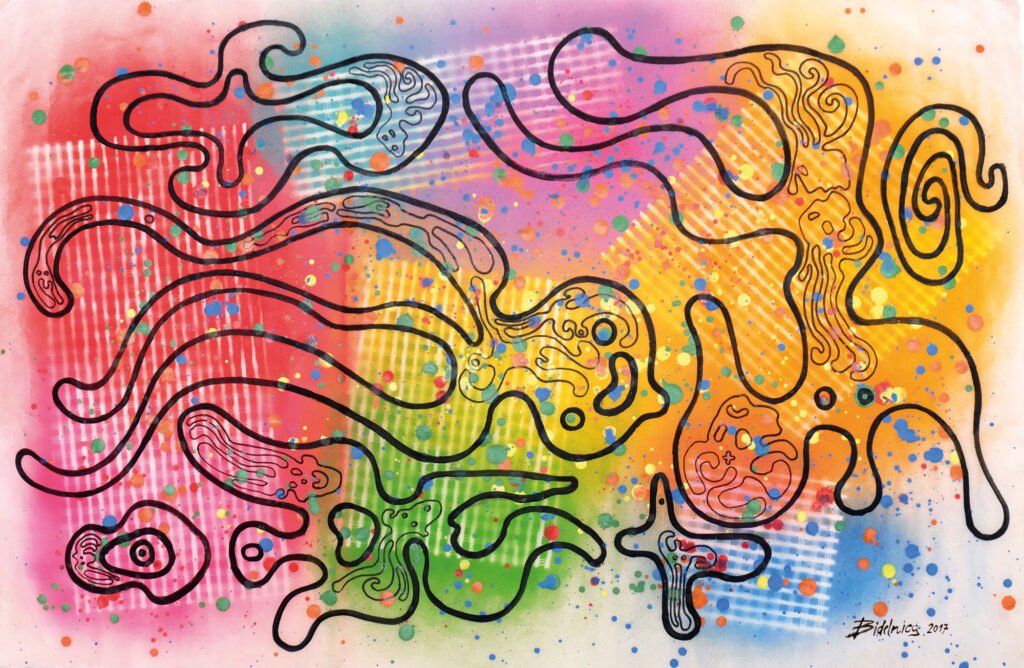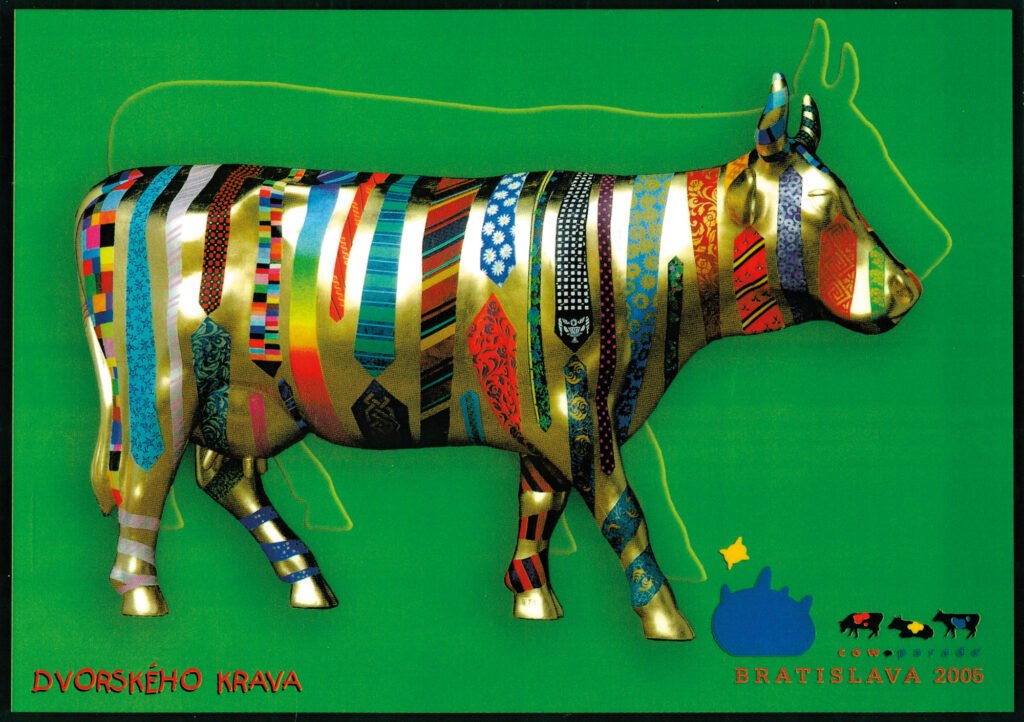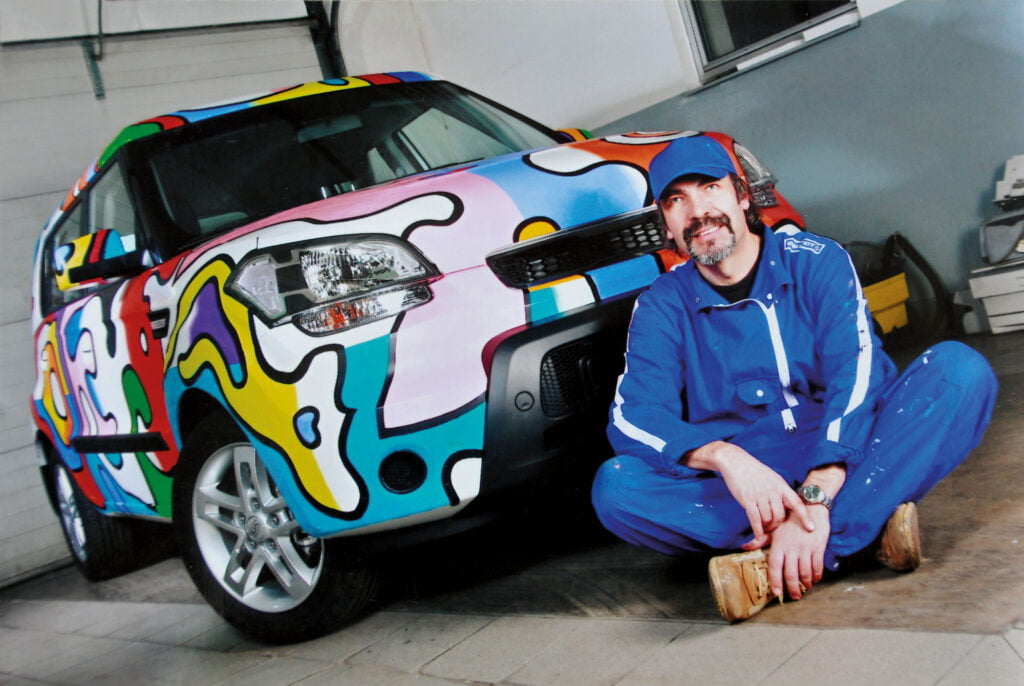Hoci nie som výtvarný teoretik, naslovovzatý znalec moderných trendov či štýlov, dovoľujem si povedať, že Daniel Bidelnica na mňa pôsobí ako maliar-solitér, teda ako umelec, ktorý nepatrí do žiadnej esteticky či ideovo vyhranenej skupiny alebo klanu, čo mu, paradoxne, poskytuje možnosť zaexperimentovať si – ale vždy v rámci toho, aby to nebolo „zaucho verejnému vkusu”, ale aby jeho dielo vyjadrovalo to, čím žije človek postmodernej epochy. Svet sa dnes mení zo dňa na deň a mnohé – ešte včera uctievané doktríny – sú dnes len prázdnymi floskulami. Bidelnica to dobre vie. Nehrá sa na žiadneho barokizujúceho či inak ornamentalizujúceho génia, nepredstiera viac obsahu či formy ako unesú jeho námety, a čo je vzácne – je to maliar, ktorý sa nehanbí priznať svojim dielam štatút istej účelovosti, ľúbivosti: jeho cyklus Žena pôsobí ako zaujímavý pokus o prienik do tajomnej psychológie, ktorou nás ženy fascinujú, zároveň však z toho „vyšperkovania”, ktoré v nich a okolo nich na obrazoch vidíme, vyžaruje istý nepokoj, niečo iritujúce, čosi, čo rozkladá tú kozmeticky bezchybnú krásu na množstvo otázok: akoby nás tie dominatné krásne tváre tlačili do akejsi submisivity. Sú to viac ako zvodkyne-vládkyne. Zároveň s tým vnímame aj iné posolstvo: farebnú hýrivosť, romantickú krásu, pripomínajúcu čaro zátiší a kytíc, ale kdesi za tým pocit z pozadia vystupujúcej dnešnej reality. V cykle Pozdrav žene akoby sa všetko obrátilo: v popredí je drsná „hranatá” realita, v pozadí ako jemný kontrast element ženskej krásy. Daniel Bidelnica nie je prvoplánový maliar. Vedia ho zaujať aj fatálnejšie, temnejšie témy. Obrazy ako Príliš mnoho smogu, Veľká pretvárka či Memento naznačujú, že vie rovnako dobre narábať s minuciózne vypracovaným motívom ako aj plagátovo vyznievajúcimi plochami, pôsobiacimi ako paravany, za ktorými sa skrýva napätie našej reality. Zaujímavé sú jeho experimenty s geometrickými tvarmi, ktoré akoby na prvý pohľad ani nepatrili do daného obrazu: akoby tam vyrušovali a naznačovali istú nekompaktnosť, možno až schválne narušenie atmosféry diela. Vnímam to ako akýsi odcudzovací efekt – sám tvorca akoby „odstúpil” od svojho diela a „uzemňoval” ho, čím vzniká pocit viacpriestorovosti, do ktorej môže vnímateľ vstúpiť. Dnešná rozporuplná doba nás často stavia pred zložité problémy, pričom pokračuje infantilizácia a „glajchšaltovanie“ hodnôt. V čase, keď vládne dobrozlo, pravdalož, keď sa ne-hľadá podstata, ale imidž, v čase totálneho úpadku estetického cítenia, patrí Bidelnica celkom určite medzi výtvarníkov, ktorí ctia vyšší princíp umeleckej výpovede, ale vedia ho skĺbiť s tým, čo si doba vyžaduje: to nie je málo, naopak. Tento monumentalista, ktorý sa nezaprie hádam ani na jedinom obraze, má svoje publikum a získava aj zaslúžené úspechy. Ďaleko od veľkých vyhlásení a trúsenia múdrych rečí maľuje diela, ktoré možno niekoho rozčuľujú, ale drvivej väčšine sa páčia. Večné je už to dnešné a to dnešné je vrchovato rozporuplné. Asi tak by som zhrnul jeho filozofiu. A dodal by som: budúcnosť zbavuje ilúzií nielen nás, ale aj obrazy. Bidelnica to vie, a preto akoby som v každom jeho obraze videl predovšetkým kus dnešného dňa.
Kamil Peteraj
Spisovateľ a básnik
Although I am not an art theorist or eminent expert on modern trends or styles, I am willing to say that Daniel Bidelnica affects me as a uniquely individual painter, as an artist, who does not belong to any aesthetically or conceptually defined group or clan, which, paradoxically, gives him the possibility to experiment, but always in the framework of the idea that he should not be a “slap in the face to public taste” but that his work should express the meaning of the life of a person in the post-modern epoch. The world is changing from day to day and much that was venerated doctrine only yesterday is empty phrases today. Bidelnica knows this well. He does not play at being a genius avowing baroque or ornamental forms, he does not pretend to create more content or form than his themes will bear, and, unusually, he is a painter who is not ashamed to admit that his works have some degree of purpose or attraction: His cycle Woman is an interesting attempt to penetrate into the mysterious psychology with which women fascinate us, but, at the same time, the “adornment” we see in them and around them, radiates a sort of discontent, something irritating, something, which breaks down the cosmetic flawless beauty into a multitude of questions: it is as if the dominant beautiful faces push us into a sort of submissiveness. They are more than seducers or rulers. At the same time, we also perceive another message: the colourful profligacy, romantic beauty, recalling the charm of the still-life and bouquet of flowers, but somewhere behind this, a feeling from the background of intruding everyday reality. In the cycle Greetings to a Woman, it is as if everything is reversed: in the foreground is the harsh “angular” reality and in the background, the element of feminine beauty as a gentle contrast. Daniel Bidelnica is not a one-level painter. More fatalistic, darker themes are also able to occupy him. Pictures like Too Much Smog, A Great Pretence or Memento indicate that he knows how to work with a minutely worked out motif just as well as with poster-sized resounding surfaces, which act as screening walls concealing the tension of our reality. His experiments with geometrical shapes are interesting. The shapes do not appear to belong to the same picture at first sight. It is as if they intruded there and showed the same lack of compactness or perhaps deliberately disturbed atmosphere of the work. I perceive this as a sort of estranging effect, as if the artist himself “stepped back” from his work and “brought it down to earth”, giving it the feeling of multiple spatiality, into which the viewer can enter. The present contradictory period often places us before complex problems, while the infantilization and levelling of values continues. At a time when good – evil and truth – lie prevail, when the essence is not sought, but the image, in a time of the total decline of aesthetic feeling, Bidelnica is one of the artists, who still respects a higher principle of artistic testimony, but knows how to combine it with the demands of the time. This is not a small achievement. This artist of monumental works, who does not deny his views even in one picture, has his public and he is achieving deserved success. Far from great declarations and scattering of wise speeches, he paints works, which may exasperate some, but please the overwhelming majority. The eternal is already today’s and this today’s is extremely contradictory. Perhaps this would sum up his philosophy. And I should add: The future will not only free us from illusions, but also pictures. Bidelnica knows this and it is as if I saw a piece of the present day in each of his pictures.
Kamil Peteraj
Writer and Poet








